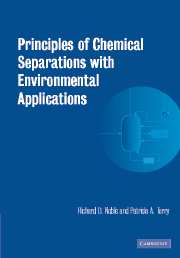Book contents
- Frontmatter
- Contents
- Preface
- 1 Introduction
- 2 Separations as unit operations
- 3 Separations analysis fundamentals
- 4 Distillation
- 5 Extraction
- 6 Absorption and stripping
- 7 Adsorption
- 8 Ion exchange
- 9 Membranes
- Appendix A Dimensionless numbers
- Appendix B Mass transfer coefficient correlations
- Appendix C Pulse analysis
- Appendix D Finite difference approach
- Appendix E Bibliography of chemical separations and related physical properties
- References
- Index
7 - Adsorption
Published online by Cambridge University Press: 26 December 2009
- Frontmatter
- Contents
- Preface
- 1 Introduction
- 2 Separations as unit operations
- 3 Separations analysis fundamentals
- 4 Distillation
- 5 Extraction
- 6 Absorption and stripping
- 7 Adsorption
- 8 Ion exchange
- 9 Membranes
- Appendix A Dimensionless numbers
- Appendix B Mass transfer coefficient correlations
- Appendix C Pulse analysis
- Appendix D Finite difference approach
- Appendix E Bibliography of chemical separations and related physical properties
- References
- Index
Summary
There is a continual exchange of ideas between all minds of a generation.
– AUGUSTE RODIN (1911)Objectives
Define the concepts of mass transfer zone, breakthrough, and exhaustion.
Use the scale-up approach and the kinetic approach to design fixed-bed adsorption columns based on laboratory or pilot column data.
Background
Adsorption is a process whereby a substance (adsorbate, or sorbate) is accumulated on the surface of a solid (adsorbent, or sorbent). The adsorbate can be in a gas or liquid phase. The driving force for adsorption is unsaturated forces at the solid surface which can form bonds with the adsorbate. These forces are typically electrostatic or van der Waals interactions (reversible). Stronger interactions involve direct electron transfer between the sorbate and the sorbent (irreversible). The strength of this interaction dictates the relative ease or difficulty in removing (desorbing) the adsorbate for adsorbent regeneration and adsorbate recovery. The selective nature of the adsorbent is primarily due to the relative access and strength of the surface interaction for one component in a feed mixture. The solid is the mass-separating agent and the separating mechanism is the partitioning between the fluid and solid phases. An energy-separating agent, typically a pressure or temperature change, is used to reverse the process and regenerate the sorbent.
Adsorption processes are used economically in a wide variety of separations in the chemical process industries. Activated carbon is the most common adsorbent, with annual worldwide sales estimated at $380 million [1].
- Type
- Chapter
- Information
- Publisher: Cambridge University PressPrint publication year: 2004
- 1
- Cited by



